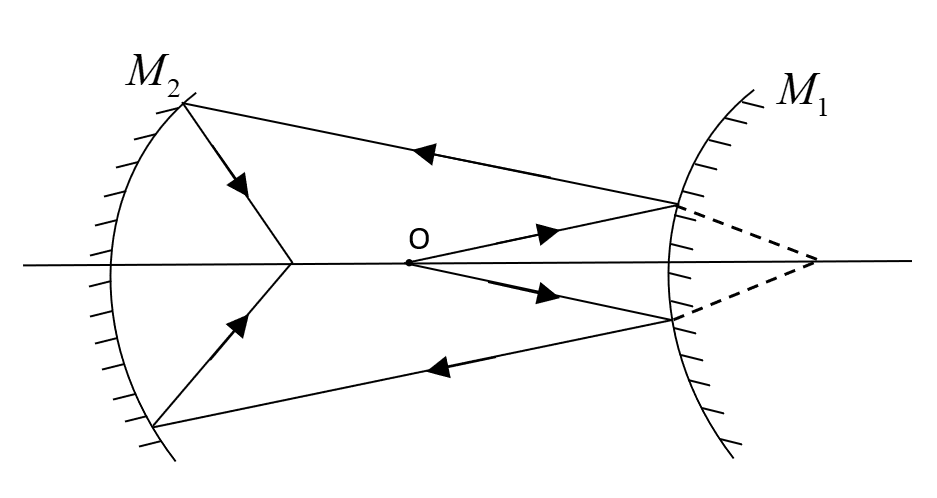
Two mirrors, one concave and the other convex, are placed 60 cm apart from with their reflecting surfaces facing each other. An object is placed 30 cm from the pole of either of them on their axis. If the focal lengths of both the mirrors are 15 cm, what will be the position of the image formed by reflection, first at the convex mirror and then at the concave mirror?
A. 19.09 cm from the pole of the concave mirror.
B. 19.09 cm from the pole of the convex mirror.
C. 11.09 cm from the pole of the concave mirror.
D. 11.09 cm from the pole of the convex mirror.
Answer
141k+ views
Hint: First the light from the object will be reflected at the convex mirror and it will create its image. Now, this image will act as a virtual object for the concave mirror, at which the reflection takes place and then the second image will be formed. Keeping in mind the sign convention, solve for the image distance for each mirror, using the Mirror Formula.
Formula used:
Mirror Formula:
Here,
Complete answer:
By Mirror Formula we know that:
Let the convex mirror at which the first reflection occurs be

It is given that the focal length of the two mirrors is 15 cm respectively and they are separated by a distance of 60 cm.
It is also given that the object is placed 30 cm from the pole of either of the two mirrors.
Now, let us first consider the reflection taking place at the convex mirror
Focal length of a convex mirror is positive, therefore,
Object distance,
Now applying Mirror Formula as given in equation (1),
This gives
Thus, the first image is formed behind the convex mirror at a distance of 10 cm from its pole.
Now, this image will act as the object for the concave mirror.
Let us now consider the reflection taking place at the concave mirror
Focal length of a concave mirror is negative, therefore,
Object distance,
Now applying Mirror Formula as given in equation (1),
Thus,
Hence, the second image is formed in front of the concave mirror at a distance of 19.09 cm from its pole.
This is the required image distance.
Thus, the correct option is A.
Note: Sign convention is very important in Ray Optics. The directions are measured from the poles of the mirror. The direction of the incident ray is considered to be positive, and any distance measured along the incident ray is positive, else every distance is negative. Therefore, in the above question, for each mirror, we have considered its own sign convention.
Formula used:
Mirror Formula:
Here,
Complete answer:
By Mirror Formula we know that:
Let the convex mirror at which the first reflection occurs be

It is given that the focal length of the two mirrors is 15 cm respectively and they are separated by a distance of 60 cm.
It is also given that the object is placed 30 cm from the pole of either of the two mirrors.
Now, let us first consider the reflection taking place at the convex mirror
Focal length of a convex mirror is positive, therefore,
Object distance,
Now applying Mirror Formula as given in equation (1),
This gives
Thus, the first image is formed behind the convex mirror at a distance of 10 cm from its pole.
Now, this image will act as the object for the concave mirror.
Let us now consider the reflection taking place at the concave mirror
Focal length of a concave mirror is negative, therefore,
Object distance,
Now applying Mirror Formula as given in equation (1),
Thus,
Hence, the second image is formed in front of the concave mirror at a distance of 19.09 cm from its pole.
This is the required image distance.
Thus, the correct option is A.
Note: Sign convention is very important in Ray Optics. The directions are measured from the poles of the mirror. The direction of the incident ray is considered to be positive, and any distance measured along the incident ray is positive, else every distance is negative. Therefore, in the above question, for each mirror, we have considered its own sign convention.
Recently Updated Pages
Young's Double Slit Experiment Step by Step Derivation

Difference Between Circuit Switching and Packet Switching

Difference Between Mass and Weight

JEE Main Participating Colleges 2024 - A Complete List of Top Colleges

JEE Main Maths Paper Pattern 2025 – Marking, Sections & Tips

Sign up for JEE Main 2025 Live Classes - Vedantu

Trending doubts
JEE Main 2025 Session 2: Application Form (Out), Exam Dates (Released), Eligibility, & More

JEE Main Exam Marking Scheme: Detailed Breakdown of Marks and Negative Marking

JEE Main 2025: Derivation of Equation of Trajectory in Physics

Electric Field Due to Uniformly Charged Ring for JEE Main 2025 - Formula and Derivation

Learn About Angle Of Deviation In Prism: JEE Main Physics 2025

Electric field due to uniformly charged sphere class 12 physics JEE_Main

Other Pages
JEE Advanced Marks vs Ranks 2025: Understanding Category-wise Qualifying Marks and Previous Year Cut-offs

JEE Advanced Weightage 2025 Chapter-Wise for Physics, Maths and Chemistry

Degree of Dissociation and Its Formula With Solved Example for JEE

JEE Main 2025: Conversion of Galvanometer Into Ammeter And Voltmeter in Physics

Dual Nature of Radiation and Matter Class 12 Notes: CBSE Physics Chapter 11

Formula for number of images formed by two plane mirrors class 12 physics JEE_Main




